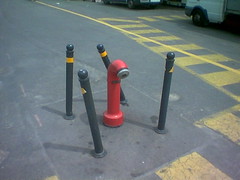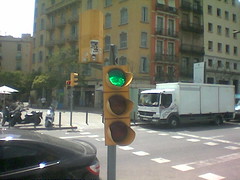The Hybrid City by Phil Hubbard
Posted: May 13th, 2008 | No Comments » In Phil Hubbard‘s fascinating book Key Ideas in Geography: the city there is a chapter on the worth reading in the context of science and technology as makers of the urban landscape. Each chapter of the book develops a critical discussion on the different perspectives that define and specify the ‘city’, suggesting that it is only by bringing these different ways of mapping the city together that we can begin to make sense of cities. The Hybrid City focuses on the current ideas about the place of technology in cities. It particularly criticizes the accounts where technology is allocated a determining role in urban life and argues that it is entwined in a more complex process of city-making. The introductory paragraphs highlight that new technologies may not be more profound than those which preceded them and as previously argumented and published:
In Phil Hubbard‘s fascinating book Key Ideas in Geography: the city there is a chapter on the worth reading in the context of science and technology as makers of the urban landscape. Each chapter of the book develops a critical discussion on the different perspectives that define and specify the ‘city’, suggesting that it is only by bringing these different ways of mapping the city together that we can begin to make sense of cities. The Hybrid City focuses on the current ideas about the place of technology in cities. It particularly criticizes the accounts where technology is allocated a determining role in urban life and argues that it is entwined in a more complex process of city-making. The introductory paragraphs highlight that new technologies may not be more profound than those which preceded them and as previously argumented and published:
The tendency to talk of new technologies in hyperbolic terms in unfortunate. One consequence is the relative neglect of ‘past’ technologies and a failure to think critically about the new social formations that are associated with successive technological innovations.
For instance, the city has often been asserted as a site of innovation and civilization, while in contrast the rural is seen as technologically backward. This goes without considering that urban centers emerged as agriculture began to create surplus of goods due to the emergence of ‘hydraulic society’. In this story, the catalyst of the formation of cities is the application of new technology seen to have profound effects for the organization and reproduction of society (that reminded me about the Farmer Technology Acceptation Index). Similarly, infrastructure networks less celebrated than the Internet such as water, sewage, gas and electricity were implicated in the making of populous cities. Some, such as the light on the street, became symbols of modernization. Other technologies during the ‘urban revolution’ replaced the traditional notion of time (qualitative time) and imposed the modern urban (quantitative) time.
The discussion on virtual cities concurs with the Infrastructure theme of Sliding Friction:
It is easy to get swept up in the hyperbole surrounding virtualism. But we should remember that virtual flow still require the construction and maintenance of complex physical infrastructure in the form of dense webs of optic cables, broadband telecom connections and location area networks (LAN).
[...]
Clearly, focusing solely on electronic and digital infrastructures when water, gas and electrical networks remain vital to industrial and domestic life deflects attention from the myriad ways the ‘old’ and ‘new’ technologies entwine in the social reproduction of urban life.
[...]
Graham (2004a) estimates fully 80 per cent of the costs of a network are associated with this traditional, messy business of getting it into the ground in highly congested urban areas.
[...]
A holistic, trans-disciplinary and robust understanding of the city as a critical amalgamation of infrastructure networks is required if we are to understand the relations between cities and technologies (and the ever-attendant threat that his relationship will break down if networks fail)
In a technological determinist approach, technology is seen to drive urbanization with successive innovation triggering major changes in the form and function of cities. Same goes with the opposing vision of ‘noir urbanism’ described for instance in City of Panic. However, a look beyond generalized and deterministic discourses about the impact of technology with empirical detail shows that technologies are woven into the fabric of city life. In same scope as my work on taxi drivers and their sat-nav system and the exploration of the entwining of the social and the technical:
This recognizes that technologies are not drivers of urban change in and themselves, and co-evolve with the urban fabric as they become woven into the social, economic and political life of cities.
In this argumentation that new technologies do not drive urban change, but are rather caught up in complex networks (or ‘socio-technical assemblages’) which incorporate all manner of actants. As described in Latour’s Paris: Ville Invisible, that considers the role of street furniture in the life o the city:
Paris is conceived as a network, then its power is diffused through an array of seemingly mundane object, each of which is, nonetheless, part of the whole. Equally, each plays a part in a complex and constantly mutating city-assemblage that holds together through the affordances and interactions of objects.
Hubbard illustrates this with the role of the pieces of rolled carpet that guide water around the gutters to clean the streets as a type of urban actor.
Some of these urban actors take the form of speed cameras, infrared car number place recognition, mobile phone tracking, digitally mediated consumption system, CCT system that transform the landscape of the contemporary city into a militarized scanscape. The spectre of cities being controlled by a faceless and unverifiable technology. However it is quite wrong to suggest that technology is becoming all-powerfull. In fact, surveillance is ultimately about the imposition of human norms and behaviors and ultimately, CCTV may not be discriminator in itself, but its operator and programmers may be (giving me some arguments to discuss on the obligatory ‘Privacy issues’ section of my thesis)
Relation to my thesis: In the end of a intensive period of paper submissions/revisions and new project proposals, I take some time to (as planned) further explore urban theories. The Hybrid City takes the concepts of urban computing and the city with a British social geography with the critical discussion of the contribution of key authors and thinkers. It has many similarities in the content and in style with Crang and Graham’s Sentient Cities Ambient Intelligence and the Politics of Urban Space and Graham’s The Cybercities Reader.



